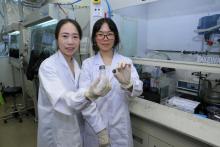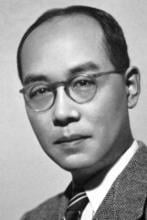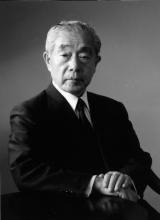Innovation
News
26 May 2020
Scratching the head or rubbing the hands repeatedly is common, unconscious behaviour when people are facing stress. Neuroscientists from the School of Biomedical Sciences and the Gerald Choa Neuroscience Centre of the Faculty of Medicine at The Chinese University of Hong Kong (CU Medicine) have discovered a mammalian brain circuitry underlying our ability to generate adaptive responses when facing stress with strong negative emotions. The result of the study was recently published in the renowned international scientific journal Nature Communications.
22 May 2020
Researchers from the School of Life Sciences at The Chinese University of Hong Kong (CUHK) and Japanese research teams have constructed a high-resolution chromosome-scale full genome sequence assembly of an American Shorthair domestic cat (AnAms1.0). By incorporating data from multiple advanced genomic technologies, this genome assembly has a much improved quality over the currently available reference. This research will drive forward precision veterinary medicine to provide the most suitable treatments based on individual differences predicted from genomic information.
14 May 2020
A research team led by Prof. Yi-Chun LU from the Faculty of Engineering at The Chinese University of Hong Kong (CUHK) has taken a critical step forward in improving high-energy batteries by introducing a novel electrolyte to the aqueous lithium-ion (Li-ion) battery. This electrolyte is commonly used in skin cream. It is inexpensive, inflammable, less toxic and is eco-friendly, yet can create stable voltage for common usage. The breakthrough was recently published in the world-leading scientific journal, Nature Materials, a sister journal of Nature.
13 May 2020
Hydrogen fuel cells made with coordination polymer glass membranes could produce as much energy as their liquid-based counterparts while adding strength and flexibility.
12 May 2020
Researchers from Daegu Gyeongbuk Institute of Science and Technology(DGIST) have developed an innovative method that allows them to visualize up to tens of different proteins simultaneously in the same cell. This technology could help scientists elucidate the complex protein interactions involved in degenerative diseases such as Alzheimer’s, deepening our understanding of their mechanisms and allowing for early detection and treatment.

27 Apr 2020
Application period now open for award programme that acknowledges and celebrates outstanding women working in STEM* research and outreach
26 Mar 2020
Concurrent Exhibition at ITEX'20: World Young Inventors Exhibition, incorporating Asian Young Inventors Exhibition and Malaysian young Inventors Exhibition.
24 Mar 2020
A new approach could lead to “cornea-on-a-chip” devices that more accurately test the effects of drugs on the human eye.
10 Mar 2020
A recent study, affiliated with South Korea's Ulsan National Institute of Science and Technology (UNIST) has introduced a novel technology, which allows carbon nanotubes (CNTs) to be easily observed under room temperature.
10 Mar 2020
Two faculty members from South Korea's Ulsan National Institute of Science and Technology (UNIST) have been honored with meritorious citations and awards for their outstanding research performance.
09 Mar 2020
A recent study, affiliated with South Korea's Ulsan National Institute of Science and Technology (UNIST) has developed high‐efficiency, solution‐processed, hybrid series, tandem photovoltaic devices featuring CQDs and organic bulk heterojunction (BHJ) photoactive materials.
05 Mar 2020
Molecular changes could improve the efficiency of next-generation photovoltaics.
05 Mar 2020
An international team of researchers, affiliated with South Korea's Ulsan National Institute of Science and Technology (UNIST) has for the first time succeeded in demonstrating the ionization cooling of muons.
02 Mar 2020
A recent study, affiliated with South Korea's Ulsan National Institute of Science and Technology (UNIST) has presented a new biofuel system that uses lignin found in biomass for the production of hydrogen.
26 Feb 2020
A recent study, affiliated with South Korea's Ulsan National Institute of Science and Technology (UNIST) has succeeded for the first time in making the crystalline silicon solar cell transparent with dark and muddy colors.
25 Feb 2020
Mayor Cheol-ho Song (Ulsan, South Korea) visited the startup facilities of Ulsan National Institute of Science and Technology (UNIST) on January 4, 2020.
24 Feb 2020
A recent study, affiliated with South Korea's Ulsan National Institute of Science and Technology (UNIST) has unveiled the structure and mechanism of proteins that are highly overexpressed in various cancers and associated with poor patient prognoses.
23 Feb 2020
South Korea's Ulsan National Institute of Science and Technology (UNIST), in collaboration with POSTECH, have developed a new biomimetic ‘moving’ surface, inspired from the biomachanics of the pectoral fins of the Batoidea.
22 Feb 2020
2 Gold, 3 Silver, 5 Bronze, and 2 Participation Awards have been bestowed upon South Korea's Ulsan National Institute of Science and Technology (UNIST) at this year's Samsung Humantech Paper Awards.
20 Feb 2020
Join over 20,000 delegates from 100+ countries at Asia’s largest innovation festival, with attendees ranging from startups to global brands, governments, academia and investors.
07 Feb 2020
A genetic engineering team of undergraduate students at The Chinese University of Hong Kong (CUHK) has been awarded a Gold medal at the International Genetically Engineered Machine (iGEM) 2019 Giant Jamboree held in Boston, USA. Under the project named “Banana Savior: The X Sense”, they have designed a rapid test for a new disease Banana Xanthomonas Wilt (BXW). They hope the novel design can help farmers in Africa and quarantine departments to realise early detection of the disease and help stop it from spreading. This is the sixth time that a CUHK team has won gold in the annual premier synthetic biology competition.
07 Feb 2020
A children’s library in a Dong minority village Gaobu, in Hunan Province, designed and built by Prof. Peter W. Ferretto and his team Condition_Lab at the School of Architecture of The Chinese University of Hong Kong (CUHK), has received the “Completed Buildings – Civic and Community” category award at this year’s World Architecture Festival (WAF).

06 Feb 2020
A nanoscale gold butterfly provides a more precise route for growing/synthesizing nanosized semiconductors that can be used in nano-lasers and other applications.
16 Jan 2020
The Smart Wearable Device Asia Pacific Summit (SWAP) 2020, hosted by Duxes, took place at the Marco Polo Hotel in Shenzhen, China, from January 13-14.
15 Jan 2020
First-of-its-kind study led by Duke-NUS Medical School and National Neuroscience Institute (NNI) applies experimental methodology using human neural cells and brain organoids to investigate mechanism underlying epileptic seizures in Angelman syndrome, an autism spectrum disorder.
13 Jan 2020
A team of NUS researchers have come up with the pH Watch, an ‘add-on’ to a wearable health monitoring gadget that can tell users about the condition of their health from their sweat pH.
31 Dec 2019
A research team, affiliated with South Korea's Ulsan National Institute of Science and Technology (UNIST) has unveiled a novel algorithm that identifies optimal pairs for composing metal-organic frameworks (MOFs).
20 Dec 2019
Professor Renjie Zhou, Assistant Professor, Department of Biomedical Engineering, The Chinese University of Hong Kong (CUHK), has been awarded the Croucher Innovation Award 2019 in the amount of HK$5 million in research expenses by the Croucher Foundation for his outstanding research achievements in optical diffraction tomography and in support of his future research works.
20 Dec 2019
Four top research academics from The Chinese University of Hong Kong (CUHK) were presented with prestigious awards from the Croucher Foundation. Professor Jianfang Wang, Professor, Department of Physics received the Croucher Senior Research Fellowship 2020. Two scholars from the Department of Medicine and Therapeutics of the Faculty of Medicine, Professor Ronald Ching Wan Ma, Professor and Head of the Division of Endocrinology and Diabetes, and Professor Siew Chien Ng, Professor, Division of Gastroenterology and Hepatology and Associate Director of the Centre for Gut Microbiota Research were awarded the Croucher Senior Medical Research Fellowships 2020. Professor Renjie Zhou, Assistant Professor, Department of Biomedical Engineering was awarded the Croucher Innovation Award 2019.
11 Dec 2019
Join Shelley Peterson, Emerging Technologies Lead and Principal Investigator for Augmented Reality at Lockheed Martin, as she speaks at EmTech Asia this February.
Events
Sorry, no events coming up for this topic.
Researchers
Sorry, no researchers coming up for this topic.
- « first
- ‹ previous
- 1
- 2
- 3
Giants in history
Physicist and statistician Prasanta Chandra Mahalanobis (29 June 1893– 28 June 1972), who founded the Indian Statistical Institute in 1931, is known for his pioneering application of statistics to practical problems.
Tetsuya Theodore Fujita (23 October 1920 – 19 November 1998) was a Japanese-American meteorologist who created the Fujita scale that classifies the strength of tornadoes based on damage to structures and vegetation.
In 1915, pathologist Katsusaburo Yamagiwa and his research assistant Koichi Ichikawa became the first to prove that chronic exposure to chemicals can cause cancer.
In 1915, Koichi Ichikawa along with pathologist Katsusaburo Yamagiwa became the first to prove that chronic exposure to chemicals can cause cancer.
A pioneer of bio-organic chemistry, Darshan Ranganathan (4 June 1941 – 4 June 2001) is remembered for developing a protocol for synthesising imidazole, a compound used to make antifungal drugs and antibiotics. Widely considered India’s most prolific researcher in chemistry, she also published dozens of papers in renowned journals on protein folding, molecular design, chemical simulation of key biological processes, and the synthesis of functional hybrid peptides and nanotubes.
In his over 30 year career in rice research, Munshi Siddique Ahmad (1924 – 19 October 2011) developed more than 30 varieties of high-yielding rice, including the BRRI Shail strain, which was responsible for increasing the rice production of Bangladesh from 8 million tonnes in 1965 to 20 million tonnes in 1975.
Hideki Yukawa (23 January 1907 – 8 September 1981) was awarded the Nobel Prize in Physics in 1949 for predicting the existence of the pi meson subatomic particle. Japan’s first Nobel laureate, Yakawa also expressed his support for nuclear disarmament by signing the Russell–Einstein Manifesto in 1955.
Ground-breaking cancer researcher Kamal Jayasing Ranadive (8 November 1917 – 11 April 2001) advanced the understanding of the causes of leukaemia, breast cancer and oesophageal cancer through the use of animal models. She was also among the first to recognise how susceptibility to cancer is linked to tumour-causing interactions between hormones and viruses.
Birbal Sahni (14 November 1891 – 10 April 1949), a pioneer of Indian palaeobotanical research, and founder of what is now the Birbal Sahni Institute of Palaeosciences in Lucknow, made multiple contributions to the study of prehistoric plants. These include the discovery of a new group of fossil gymnosperms (named Pentoxylae), reconstruction of the extinct Williamsonia sewardiana plant, and description of a new type of petrified wood from the Jurassic age.
The research of Filipino pharmaceutical chemist Luz Oliveros-Belardo (3 November 1906 – 12 December 1999) focussed on essential oils and other chemicals derived from native Philippine plants.
Japanese chemist Kenichi Fukui (4 October 1918 – 9 January 1998) was the first Asian scientist to be awarded the Nobel Prize in Chemistry. Together with Roald Hoffman, he received this honour in 1981 for his independent research into the mechanisms of chemical reactions.
Filipina chemist María Orosa (29 November 1892–13 February 1945) fought malnutrition and food insecurity in the Philippines by devising over 700 culinary creations including Soyalac, a nutrient rich drink made from soybeans, and Darak, rice cookies packed with Vitamin B1, which could prevent beriberi disease caused by Vitamin B1 deficiency. She was also a partisan of the guerrilla movement resisting Japanese occupation during World War II, and died after being struck by shrapnel while working in her laboratory during the Battle of Manila.
Research by Filipino plant scientist Benito Vergara (23 June 1934 – 24 October 2015) on the physiology of rice led to the development of deep-water and cold-tolerant rice varieties. Vergara also made several contributions to expanding public awareness of rice science.
Filipino chemist and pharmacist Manuel A. Zamora (29 March 1870 – 9 July 1929) is best remembered for his discovery of the tiki-tiki formula to combat beriberi, a disease caused by Vitamin B1 deficiency.
In 1939, biochemist Kamala Sohonie (18 June 1911 – 28 June 1998) became the first woman to be accepted into the Indian Institute of Science (IISc).
Korean parasitologist Seung-Yull Cho (16 November 1943 – 27 January 2019) is remembered largely for his pioneering works to control infections caused by helminthic parasites and his contribution to journal publishing.
Chinese agronomist Yuan Longping (7 September 1930 – 22 May 2021) developed the first varieties of the high-yield, hybrid rice that brought food security to multiple countries including China, which had been ravaged by food shortages as recently as the mid-20th century.
Fe Villanueva del Mundo (27 November 1911 – 6 August 2011) was a Filipina paediatrician who founded the Philippines’ first paediatric hospital.
After witnessing death and suffering as a youth in his home village during World War II, Nguyễn Tài Thu (6 April 1931 – 14 February 2021) set his sights on alleviating pain by becoming a doctor. After studying Traditional Chinese Medicine in China in the 1950s, Thu returned to Vietnam to serve in military hospitals. Eventually, he became the country’s foremost practitioner of acupuncture, a technique he first learned by inserting needles into himself.
Minoru Shirota (April 23, 1899 – March 10, 1982) was a Japanese microbiologist who invented the popular fermented drink Yakult.
Wu Lien-teh (10 March 1879 – 21 January 1960) was a Malaysian-born doctor who invented a mask that effectively suppressed disease transmission. Winning the prestigious Queen’s Scholarship enabled Wu to become the first Chinese student to study medicine at the University of Cambridge.
Physicist Narinder Singh Kapany (31 October 1926 – 4 December 2020) pioneered the use of optical fibres to transmit images, and founded several optical technology companies. Born in Punjab, India, he worked at a local optical instruments factory before moving to London for PhD studies at Imperial College. There, he devised a flexible fibrescope to convey images along bundles of glass fibres.
Japanese physicist Ukichiro Nakaya (1900-1962) made the world’s first artificial snowflakes. He started his research on snow crystals in the early 1930s at Hokkaido University, where there is an unlimited supply of natural snow in winter. By taking over 3,000 photographs, he established a classification of natural snow crystals and described their relationship with weather conditions.
David T. Wong (born 1936) is a Hong Kong-born American neuroscientist who is best known for discovering the antidepressant drug fluoxetine, better known as Prozac.
The techniques that make industrial pearl culturing possible were developed over a century ago at the Misaki Marine Biological Station in Japan. The station’s first director, Professor Kakichi Mitsukuri, emphasized to Kokichi Mikimoto in 1890 that stimulating pearl sac formation was important for pearl growth, and they went on to successfully develop methods for culturing pearls.
The field of solid-state ionics originated in Europe, but Takehiko Takahashi of Nagoya University in Japan was the first to coin the term ‘solid ionics’ in 1967. ‘Solid-state ionics’ first appeared in 1971 in another of his papers, and was likely a play on ‘solid-state electronics’, another rapidly growing field at the time.
Charles Kuen Kao (Nov. 4, 1933 to Sept. 23, 2018) was an engineer who is regarded as the father of fibre optics. His work in the 1960s on long distance signal transmission using very pure glass fibres revolutionized telecommunications, enabling innovations such as the Internet.
Cyril Andrew Ponnamperuma (16 October 1923 – 20 December 1994) was a Sri Lankan chemist who was interested in the origins of life on Earth. His research in chemical evolution showed how inanimate molecules may have given rise to the building blocks of life – a process known as abiogenesis.
Motoo Kimura (13 November 1924 – 13 November 1994) was a Japanese theoretical population geneticist who is best remembered for developing the neutral theory of molecular evolution.
Meghnad Saha (6 October 1893 – 16 February 1956) was an Indian astrophysicist best known for formulating the Saha ionization equation which describes the chemical and physical properties of stars.
Sir Jagadish Chandra Bose (30 November 1858 – 23 November 1937) was a scientist and inventor who contributed to a wide range of scientific fields such as physics, botany and biology.
Osamu Shimomura (27 August 1928 – 19 October 2018) was a Japanese organic chemist and marine biologist who dedicated his career to understanding how organisms emitted light.
Woo Jang-choon (8 April 1898 – 10 August 1959) was a Korean-Japanese agricultural scientist and botanist.
Subrahmanyan Chandrasekhar (19 October 1910 – 21 August 1995) was an Indian astrophysicist who studied the structure and evolution of stars.
Mathematician Maryam Mirzakhani (12 May 1977 – 14 July 2017) was the first and only woman and Iranian to date to win the Fields Medal in 2014 for her work on curved surfaces.
Sir Chandrasekhara Venkata Raman (7 November 1888 – 21 November 1970) was an Indian physicist who performed ground-breaking research in the field of light-scattering.
Mohammad Abdus Salam (29 January 1926 – 21 November 1996) was a theoretical physicist and the first Pakistani to receive a Nobel Prize in science.
Srinivasa Ramanujan (22 December 1887 – 26 April 1920) was a math prodigy and widely considered one of India’s greatest mathematicians. Despite having almost no formal training in mathematics, he made substantial contributions to mathematical analysis, number theory, infinite series and continued fractions.
Gopalasamudram Narayanan Ramachandran (8 October 1922 – 7 April 2001) is best known for developing the Ramachandran plot to understand the structure of short chains of amino acids, known as peptides.
Bacharuddin Jusuf Habibie (25 June 1936 – 11 September 2019) was an Indonesian engineer who was President of Indonesia from 1998 to 1999.
Abdus Suttar Khan (c. 1941 – 31 January 2008) was a Bangladeshi engineer who spent a significant part of his career conducting aerospace research with NASA, United Technology and Alstom.
Chien-Shiung Wu (31 May 1912 – 16 February 1997) was an experimental physicist who made several important contributions to nuclear physics. Wu worked on the Manhattan Project – a top-secret program for the production of nuclear weapons during World War II and helped to develop a process for separating uranium into U235 and U238.
Julian Arca Banzon (13 March 1908 – 13 September 1988) was a biochemist from the Philippines who was a pioneer in alternative fuel research. Banzon investigated the use of indigenous crops as sources of renewable fuels and chemicals.
Rajeshwari Chatterjee (24 January 1922 – 3 September 2010) was the first female engineer from Karnataka in India.
Fazlur Rahman Khan (3 April 1929 – 27 March 1982) was a Bangladeshi-American structural engineer and architect who invented the tube principle, which formed the basis for modern skyscraper design.







































































